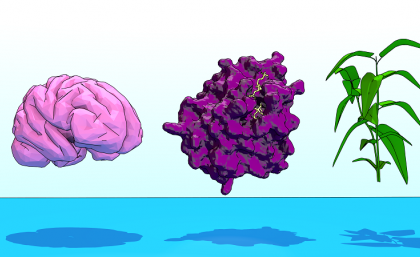
Research into the self-destruction of cells in humans and plants could lead to treatments for neurodegenerative brain diseases and the development of disease-resistant plants.
A study co-led by The University of Queensland’s Professor Bostjan Kobe identified the role certain proteins play in cellular suicide.
“To sustain life, diverse organisms like humans and plants have cells that commit suicide for the benefit of the rest of the organism,” Professor Kobe said.
“This is a key part of our own immune response – infected cells will often commit suicide, so the greater organism can live.
“Surprisingly though, studying proteins involved in the cell death process in human neurons has led us to discover how cell death also occurs in plants.
“We’ve found common ways human and plant cells bring about cell suicide.”
The team used a combination of structural biology, biochemistry, neurobiology and plant science to analyse cells and proteins, laying the foundation for some potentially ground-breaking innovations.
“Neurodegenerative diseases affect millions of people worldwide, and come about for different reasons, but what connects them is the breakdown of brain cells,” Professor Kobe said.
“A particular protein – SARM1 – is essential for this brain cell breakdown across different neurodegenerative diseases.
“We’ve provided crucial information about this protein – revealing its three-dimensional structure – that will accelerate the development of drugs that could delay or stop this breakdown.”
A better understanding of cell death processes may also lead to the development of disease-resistant plants, helping boost yields, minimise waste and bolster food security.
“Food security is similarly an increasingly relevant problem worldwide,” Professor Kobe said.
“Plant diseases account for more than 15 per cent of crops losses per year, before they’re even harvested.
“Specific plant resistance genes can protect plants from disease, but how the products of these genes work has been poorly understood.
“Part of this resistance is that – similar to human neurons – infected cells self-destruct.
“Knowing how this process happens in neurons, we were able to find how resistance comes about in plants.
“This takes us a step closer to making effective synthetic resistance genes that can be used to provide additional protection in Australia and worldwide from crop diseases.”
The research has been published in Science (DOI: 10.1126/science.aax1911).
It was led by researchers at UQ, The Australian National University, Griffith University and CSIRO, with a host of international collaborators in the US, UK and Australia.
Media: Professor Bostjan Kobe, b.kobe@uq.edu.au, +61 407 009 170; Dr Hayden Burdett, h.burdett@uq.edu.au, +61 468 894 467; Dominic Jarvis, dominic.jarvis@uq.edu.au, +61 413 334 924.
.jpg)










